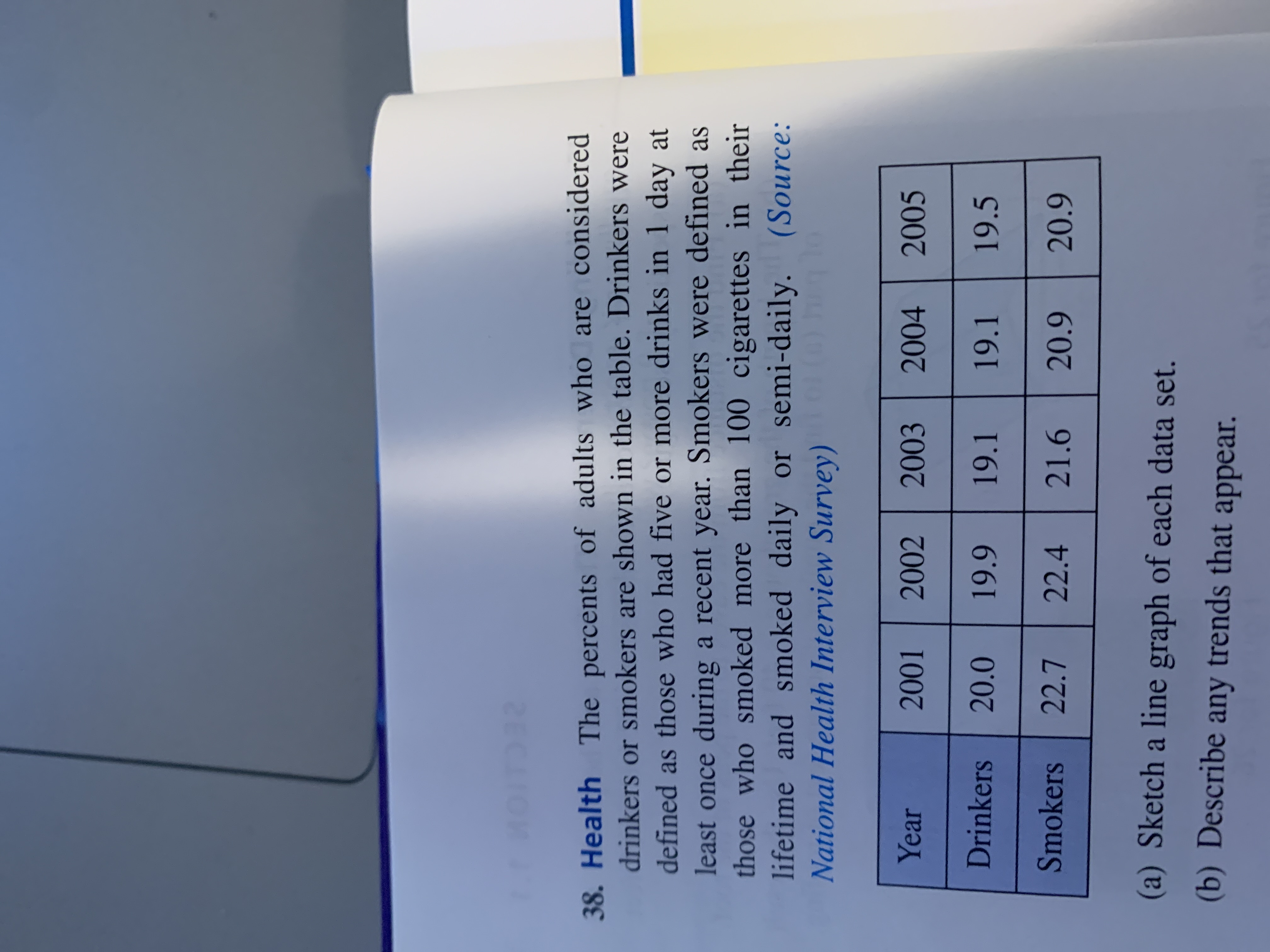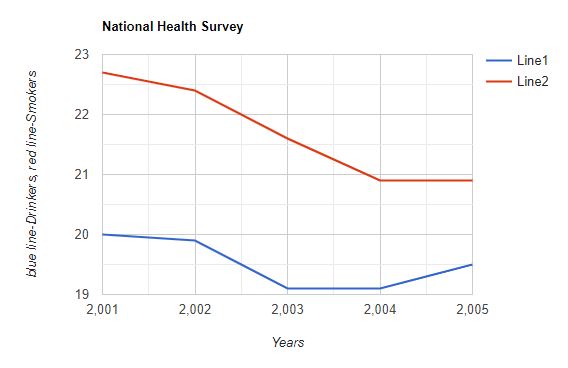
Calculus: Early Transcendentals
8th Edition
ISBN: 9781285741550
Author: James Stewart
Publisher: Cengage Learning
expand_more
expand_more
format_list_bulleted
Topic Video
Question
Question is on photo.

Transcribed Image Text:### Health Statistics
The table below presents the percentage of adults considered drinkers or smokers over several years.
- **Drinkers** are defined as individuals who had five or more drinks in one day at least once during a recent year.
- **Smokers** are those who smoked more than 100 cigarettes in their lifetime and smoked daily or semi-daily.
**Data Source: National Health Interview Survey**
| Year | 2001 | 2002 | 2003 | 2004 | 2005 |
|---------|------|------|------|------|------|
| Drinkers (%) | 20.0 | 19.9 | 19.1 | 19.1 | 19.5 |
| Smokers (%) | 22.7 | 22.4 | 21.6 | 20.9 | 20.9 |
#### Questions:
(a) Sketch a line graph for each data set.
(b) Describe any trends that appear.
---
### Graph Description:
When sketching a line graph for this data:
- **X-axis (horizontal)**: Represents the years from 2001 to 2005.
- **Y-axis (vertical)**: Represents the percentage of adults (ranging roughly from 18% to 23%).
#### Drinkers:
- Begin at 20.0% in 2001, slightly decreasing each year, reaching 19.1% by 2003 and 2004, and then increasing to 19.5% in 2005.
#### Smokers:
- Start at 22.7% in 2001 and show a gradual decline each year, landing at 20.9% in 2004 and maintaining that level in 2005.
### Trend Analysis:
- **Drinkers**: The percentage shows a general decline from 2001 to 2004, followed by a slight increase in 2005.
- **Smokers**: There is a consistent decreasing trend from 2001 to 2005.
This data suggests a gradual reduction in both drinking and smoking rates over the years, with a small uptick in drinking in 2005.
Expert Solution
arrow_forward
Step 1
a)
Plot the number of drinkers and smokers on the y-axis and years on the x-axis

Step by stepSolved in 2 steps with 1 images

Knowledge Booster
Learn more about
Need a deep-dive on the concept behind this application? Look no further. Learn more about this topic, calculus and related others by exploring similar questions and additional content below.Similar questions
arrow_back_ios
arrow_forward_ios
Recommended textbooks for you
 Calculus: Early TranscendentalsCalculusISBN:9781285741550Author:James StewartPublisher:Cengage Learning
Calculus: Early TranscendentalsCalculusISBN:9781285741550Author:James StewartPublisher:Cengage Learning Thomas' Calculus (14th Edition)CalculusISBN:9780134438986Author:Joel R. Hass, Christopher E. Heil, Maurice D. WeirPublisher:PEARSON
Thomas' Calculus (14th Edition)CalculusISBN:9780134438986Author:Joel R. Hass, Christopher E. Heil, Maurice D. WeirPublisher:PEARSON Calculus: Early Transcendentals (3rd Edition)CalculusISBN:9780134763644Author:William L. Briggs, Lyle Cochran, Bernard Gillett, Eric SchulzPublisher:PEARSON
Calculus: Early Transcendentals (3rd Edition)CalculusISBN:9780134763644Author:William L. Briggs, Lyle Cochran, Bernard Gillett, Eric SchulzPublisher:PEARSON Calculus: Early TranscendentalsCalculusISBN:9781319050740Author:Jon Rogawski, Colin Adams, Robert FranzosaPublisher:W. H. Freeman
Calculus: Early TranscendentalsCalculusISBN:9781319050740Author:Jon Rogawski, Colin Adams, Robert FranzosaPublisher:W. H. Freeman
 Calculus: Early Transcendental FunctionsCalculusISBN:9781337552516Author:Ron Larson, Bruce H. EdwardsPublisher:Cengage Learning
Calculus: Early Transcendental FunctionsCalculusISBN:9781337552516Author:Ron Larson, Bruce H. EdwardsPublisher:Cengage Learning

Calculus: Early Transcendentals
Calculus
ISBN:9781285741550
Author:James Stewart
Publisher:Cengage Learning

Thomas' Calculus (14th Edition)
Calculus
ISBN:9780134438986
Author:Joel R. Hass, Christopher E. Heil, Maurice D. Weir
Publisher:PEARSON

Calculus: Early Transcendentals (3rd Edition)
Calculus
ISBN:9780134763644
Author:William L. Briggs, Lyle Cochran, Bernard Gillett, Eric Schulz
Publisher:PEARSON

Calculus: Early Transcendentals
Calculus
ISBN:9781319050740
Author:Jon Rogawski, Colin Adams, Robert Franzosa
Publisher:W. H. Freeman


Calculus: Early Transcendental Functions
Calculus
ISBN:9781337552516
Author:Ron Larson, Bruce H. Edwards
Publisher:Cengage Learning